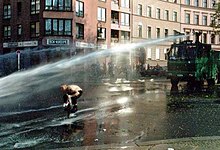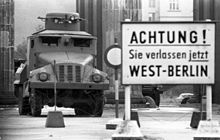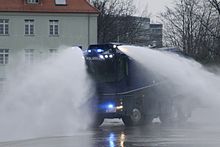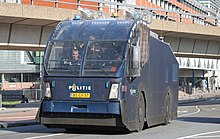water cannon
Water cannons ( called “WaWe” in the parlance of the German police ) are special vehicles with large water tanks and movable spray pipes for shooting (“throwing”) water , which may contain chemical admixtures, under high pressure (up to 20 bar = 2 MPa ). They are long-range weapons that are used by police and security agencies around the world. In Germany these are the closed associations of the federal police and the riot police of the federal states .
Mission profile

Water cannons are used as a means of averting danger , especially during demonstrations and street battles , in order to keep larger groups of people under control. This is done in order to enforce measures by force in the context of immediate coercion . When this may happen is clearly regulated in Germany by the police service regulation PDV 122 . These can also be missions whose mission goal cannot be achieved with human resources alone or not in the required time, such as clearing sit-ins . Furthermore, water cannons can also be used in firefighting, for example in the case of barricades set on fire or, due to the mostly existing all-wheel drive and its off-road mobility, also in forest fires. In some states, these vehicles have clearance or locking devices.
Areas of application
- Clearance in particular of streets, squares and other parts of the site
- Securing police barriers
- Securing and protecting buildings, systems, facilities and the like
- Fighting fires during police operations such as barricade fires and to support the fire brigade (the fire brigade also has its own water cannon equipment )
- Securing the drinking water supply in the event of disasters
Types of use
The water can be delivered as a burst of water , rain or as a water barrier:
- The surge of water is aimed specifically at individual people. If the operating pressure is too high, a direct surge of water can cause serious injury, so there are restrictions on pressure regulation.
- In the case of water rain, the jet is emitted indirectly and over the entire area in order to force larger groups of people back through the wet.
- The water barrier is intended to secure areas that have already been cleared against being reoccupied, or to create the possibility for emergency services to form behind the barrier. In older water cannons with simple full jet pipes, this is done by moving the jet pipes pendularly towards the ground. Modern water cannons, including the 10000 water cannon, which is new for the German authorities , also offer the option of fanning out the water jet by changing the jet patterns of the main jet pipes and of building a so-called water shield with additional side nozzles, which should act as a barrier.
Chemical admixtures
Irritants such as 2-chlorobenzylidenemalonic acid dinitrile (CS) or ω-chloroacetophenone (CN) can be mixed into the water in per mille concentration, which rain down as an aerosol . In many countries the admixture of irritants is regulated by law, in some cases prohibited.
Germany
history
Water cannons were used for regulatory tasks as early as the 1930s. At the premiere of the film Nothing New in the West , water cannons were used to enforce a ban on demonstrations.
Up until the 1960s, water cannons played practically no role in everyday police operations. The use of water to control suspected violent groups (wording of the law: Störer ) was limited to water hoses on the fixed hydrants . Beginning with the 1968 movement , the state police in Germany, and from 1974 also the Federal Border Police, bought large numbers of the all-terrain WaWe 4000 (4000 l water supply), which was mainly based on the short-hooded Mercedes LA 1113 chassis with a Metz body .
In what was then West Berlin , where the first WaWe 64 had already been procured in the mid-1960s, they designed their own type of water cannon, the WaWe 69 ( Mercedes LPS 338 ) with a specially protected Hodermann structure made of 7 mm thick armored steel.
With the introduction of the new Mercedes forward control cabin , a successor model for the WaWe 4000, the WaWe 6000, was developed in the mid-1970s . This model was then also used in Berlin; The sign “Please keep your distance” on the tank structure was and still is characteristic of the Berlin water cannons. The WaWe 6000 was based on a two-axle all-wheel-drive chassis of the type Mercedes 1719. The forward control cab of the then current NG series with a double cab that is more typical of the fire service was raised with an attached turret in the rear. There were only a few copies of this type; Besides Berlin, they were mainly stationed in northern Germany. Most police authorities switched directly from the WaWe 4000 to the WaWe 9000 , which was developed in 1979 and manufactured in series from the mid-1980s. The last WaWe 4000 retired in 1996 from the Saxon riot police.
Political and legal situation
The use of water cannons is often controversial and always associated with the risk of legal consequences for the operations manager, whereby the question of the proportionality of the water cannon use must be clarified. The magazine Stern criticized in 1984, around the time when today's 9000 water cannons were introduced, that high pressure water cannons were comparable in terms of their effect to a projectile weapon with a wide area effect, but are only defined as an aid in the legal text. This means that the decision about the use lies on the lower management levels and is not subject to reporting in the same way as the possible use of firearms. So the threshold of a possible use is to be settled rather low.
If violent troublemakers mingle with peaceful demonstrators, the water cannon can no longer be used to only keep the troublemakers at a distance; both groups are inevitably hit when deployed. The police service regulation 122 mentioned at the outset regulates at least that the use of water cannons - also to inform the emergency services - must be announced several times over loudspeakers in order to give bystanders the opportunity to get to safety. The threat of use comes with dismissals accompanied so that people who are staying for a sending off in an area where a water cannon, this ordnungswidrig do and bear the risk of police coercion (u. A. Water use).
Victim
In the past, the use of irritants or targeted jets of water led to injuries more often and were also the subject of lawsuits. One case was the subject of media reports in the mid-1980s when the 36-year-old machine fitter Günter Sare was run over and killed by a water cannon during a riot at an NPD counter-demonstration in Frankfurt am Main . On September 30, 2010, during a demonstration against the Stuttgart 21 project, the meeting participant Dietrich Wagner was hit head-on in the eyes with water cannons, so that he became almost blind.
equipment

In March 2015, a total of 61 of the original 116 water cannons were still in use in Germany. The federal police had a total of 15 and the state riot police 46 water cannons of the type WaWe 9000 and the successor model water cannon 10000 (WaWe 10) stationed mainly at some of their federal and riot police departments. Older models (WaWe 4000/6000) are no longer in use or are only used for training purposes. The WaWe 9000 are based exclusively on Mercedes-Benz all-wheel drive chassis of the Mercedes-NG and later the SK series , the assembly was carried out by the companies Metz (prototypes) and Ziegler (series), which as body manufacturers mainly equip fire-fighting vehicles. Vehicles from the first years of procurement have now been withdrawn, serve as part donors or are given to volunteer fire brigades.
future
The 9000 water cannons, some of which are over 20 years old today, are to be replaced by the next generation, the 10000 water cannons, by 2019. While WaWe 9000 based on the successor series Mercedes Actros and Axor (otherwise technically unchanged) or, as in Belgium, a new model from Ziegler based on MAN have been used in Switzerland for several years , in Germany tenders for vehicles from . Rosenbauer used that have water supply over 10,000 liters and can these 3 jet pipes, including a full rear lance post.
The vehicles are based on MB Actros all-wheel drive chassis of the type 3341 6x6 AK and are protected considerably more expensively than before: instead of the standard cabs and cowls that were previously used, the entire structure including the driver's cab was manufactured by Rosenbauer. The entire shape of the vehicle without horizontal surfaces prevents incendiary devices (" Molotov cocktails ") from remaining on the roof and the body should withstand the throwing of pavement slabs from a height of over 10 meters. For the first time there is the possibility that the water cannons can supply each other with water and the water can not be released as a direct jet as before, but also as a so-called water bell and as a shield to the sides. The changeability of the jet pattern is particularly important for extinguishing tasks such as burning barricades. In the course of decommissioning old water cannons, the number of these vehicles will be reduced to 78; the summary then only takes place at the operational focus. The first prototype has been available since the beginning of December 2009 and was tested over a period of three months in Hamburg and Berlin; procurement is now running nationwide for the federal and state governments. The funds for the purchase have been approved. A WaWe 10000 costs around 900,000 euros.
GDR

In the GDR , type SK-2 water cannons (special motor vehicle 2, a water cannon based on the G5 G5 truck ) and later the Hydromil type (a water cannon based on the Polish Star 29 truck ) were in use. Use of the SK-2 took place u. a. during the construction of the Berlin Wall at the Brandenburg Gate in 1961.
Austria and Denmark
The Austrian Federal Police use two-axle Scania chassis and superstructures from Rosenbauer for their water cannons , which are also used in Denmark. The tank holds 4,000 liters. Noticeable about these are the additional grating of the windows, the equipment carrier for clearing blades and the all-round cladding of the vehicle floor. The launcher system is arranged diagonally.
Belgium
The Belgian police (Federale Politie) used specially protected vehicles from the body manufacturer MOL until around 2010 . Of this type MOL MSB 18, in the jargon “Arro” ( French for arroseuse, explosive wagon ), 18 vehicles have been in use since 1989. In addition to the original police tasks, these vehicles can also be used for emergency supplies (fire, floods). The dimensions correspond roughly to the German WaWe 9000, the permissible total weight, however, 28 t, the water supply is also 9000 liters. The vehicles are powered by a Caterpillar diesel engine with 6 cylinders and 201 kW, the pump output of the turret system is 900 l / min.
These aging vehicles are gradually being replaced by models made in Germany (see illustration). The base vehicle is a MAN chassis with single tires, the body including the crew cabin comes from Ziegler. These vehicles are increasingly being used in Switzerland. There they are based on chassis from Mercedes-Benz.
Switzerland
Various models are in use in Switzerland, some of which are identical to the German WaWe 9000, and these have recently also been based on Actros and Axor chassis. The new Ziegler model used in Belgium is also used there, albeit with an Actros base.
Poland
In Poland, water cannons from the fire brigade body manufacturer ISS Wawrzaszek are mainly used under the designation Tajfun (I-III) . Depending on the type, these are based on two or three-axle Scania or Renault-Kerax chassis and, depending on the type, have a water tank of between 5000 and 9000 liters. The two projector monitors are arranged one above the other in the middle, the upper one on the vehicle roof and the lower one on the front of the vehicle below the windshield. These vehicles also have clearing shields, laterally extendable shut-off shields or protective shields and side protective showers. The vehicles are operated by a driver and two launchers who are also in the front. They replace the old Hydromil II vehicles , which were based on Jelcz chassis .
Netherlands
The Dutch riot police (mobiele eenheid) currently operates six of the water cannons shown by the Dutch bodybuilder Terberg at three locations. The vehicles are built on Volvo chassis and have a water supply of 8,000 liters.
Turkey
Water cannons became known in Turkey under the term TOMA (tr: Toplumsal Olaylara Müdahale Aracı , vehicle for intervention in social (social) events), especially during the protests in Turkey in 2013 . They are made by the Izmir- based Katmerciler AG, Nurol in Ankara and Otokar , a subsidiary of Koç Holding .
In June 2013, Prime Minister Recep Tayyip Erdoğan ordered 30 TOMAs from Katmerci and the company was hoping to export from Brazil to Libya . The Nurol company claims that their TOMA are used by the police and gendarmerie in Turkey and are actively used in Azerbaijan , Libya, Zimbabwe , Georgia and Kazakhstan . With a unit price of $ 171,000, the Katmerci company is well below the cost of the "Water Cannon 10000" manufactured by Rosenbauer for the German police, which stood at $ 1.33 million in November 2009.
According to a report by Amnesty International on October 2, 2013, the use of water cannons in Turkey caused injuries due to both high pressure water and the addition of chemicals. In response to a parliamentary question, the former Interior Minister Muammer Guler confirmed that, if necessary, oleoresin capsicum , a mixture of active ingredients contained in the pepper spray , would be added to the water .
United Kingdom
The use of water cannons by the police is not permitted in England and Wales , but they were used in Northern Ireland .
See also
literature
- Hans Georg Isenberg, Ursula Isenberg: Police vehicles from all over the world . NGV Naumann & Göbel, Cologne 2007, pp. 15f, 81, ISBN 978-3-625-11520-5 .
- Horst Wisser: City life in the 50s and 60s revised new edition, Wartberg, Gudensberg-Gleichen 2010, p. 56f, ISBN 978-3-8313-2347-0 .
- Anti- WAA office, Schwandorf (ed.): Rubber bullets, water cannons, CS: rapid shutdown of civil rights; the police's new weapons . Environmental Protection Association Unterelbe , Hamburg 1986, ISBN 3-88876-036-4 .
Web links
- Data sheet and picture of an old WaWe 4000 at PMC Marburg
- An overview of the water cannons then and now at the Berlin police on polizeiautos.de
- Data sheet of the new Ziegler model at the Belgian police (Dutch text)
- How many water cannons does a democracy need?
- Photos from the first WaWe 10,000 when it was handed over to the Hamburg police on February 10, 2011
Individual evidence
- ↑ a b How many water cannons does a democracy need? gulli.com , October 26, 2010; archived from the original on December 28, 2010 ; Retrieved December 28, 2010 .
- ↑ Hans-Jürgen Schmidt: We carry the eagle of the federal government on the rock - Chronicle of the Federal Border Guard 1951-1971 Fiedler-Verlag, Coburg 1995 ISBN 3-923434-17-0 , p. 59
- ↑ Almost blind activist wants apology from Mappus in: Spiegel Online from December 28, 2010
- ↑ RP Online from October 9, 2010: Water cannon seriously injured Dietrich Wagner: Stuttgart demonstrator threatens to go blind ( memento of the original from October 12, 2010 in the Internet Archive ) Info: The archive link was automatically inserted and not yet checked. Please check the original and archive link according to the instructions and then remove this notice.
- ↑ Number of water cannons at federal and state authorities. March 15, 2015, accessed August 13, 2017 .
- ↑ a b Der Nassmacher on Spiegel-Online from 7 December 2009
- ^ DPolG announcement New water cannons from 2010 for federal and state governments
- ↑ HAZ ( online )
- ↑ taz article an eye for an eye (November 21, 2010)
- ↑ BM.I press text The service weapons of the Federal Police accessed on May 11, 2010
- ↑ Image of a WaWe 9 on a DC Actros at the Zurich Cantonal Police (French text) ( Memento of the original from June 29, 2009 in the Internet Archive ) Info: The archive link was inserted automatically and has not yet been checked. Please check the original and archive link according to the instructions and then remove this notice.
- ↑ The full name of the company founded by Ismail Katmerci, former MP of the ruling Justice and Development Party ( AKP ), is Katmerciler Araç Üstü Ekipman Sanayi ve Ticaret A.Ş. (Industry and trade for equipment on vehicles AG) and has a homepage in several languages; here English ; Accessed April 10, 2014
- ↑ Full name is: Nurol Makina ve Sanayi AS (Nurol Maschinen und Industrie AG) with a homepage in English ; Accessed April 10, 2014
- ↑ a b See an article on Bloomberg News from August 15, 2013 Turkey Riot Trucks Spur Share Gain for Ex-Lawmaker Katmerci ; Accessed April 10, 2014
- ↑ See the company's English page on the "riot control vehicle" ( memento of the original from December 16, 2013 in the Internet Archive ) Info: The archive link was automatically inserted and not yet checked. Please check the original and archive link according to the instructions and then remove this notice. ; Accessed April 10, 2014
- ↑ The report GEZI PARK protest: Brutal denial of the right to peaceful assembly in Turkey is available only in English; Accessed April 10, 2014
- ↑ See a message from Sözcü from December 26, 2013 Muammer Güler'den TOMA itirafı! ; Accessed April 10, 2014
- ^ Alan Travis, Theresa May rejects Boris Johnson's request to use water cannon. The Guardian, July 15, 2015 (accessed November 19, 2018).












